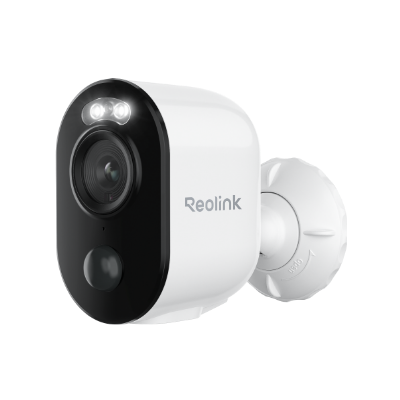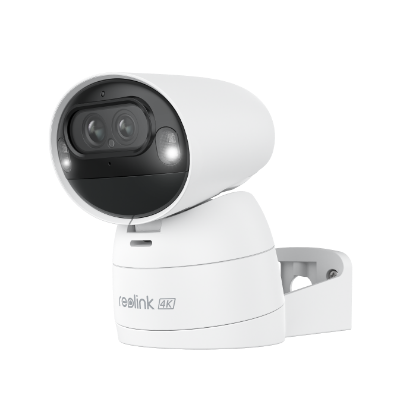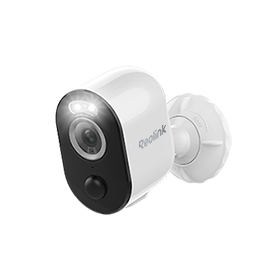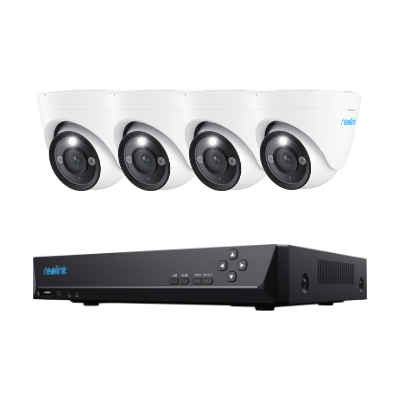The Ultimate Guide to the Local Storage Security Camera

For people planning to install security cameras in their homes or businesses, one crucial factor to consider is how and where to store the camera’s footage. The options for security camera storage can be overwhelming, but local storage security cameras have emerged as a popular choice due to their ability to store data without requiring internet connectivity or cloud solutions, providing users with greater control and data privacy.
In this post, we will dive into the nitty-gritty of security cameras with local storage, covering everything you need to know about their features, our top picks, and best practices for local storage. If you are considering installing a security camera in your home or business, this guide will help you make an informed decision.
Reolink New Year Sale - Save Big with Exclusive Deals!
Save big with Reolink! New Year Sale up to 45% off on security cameras, doorbells, and systems — Dec. 8 to Jan. 4.
What Is A Local Storage Security Camera?
A local storage security camera is a type of security camera that stores recorded footage on a local storage device, such as an SD card or a hard drive. These cameras are designed to capture footage of activities within a specific area and provide an additional layer of security for homes and businesses without requiring you to store your footage in the cloud.
Security cameras with local storage are equipped with sensors that are triggered by movement or sound. When activity is detected, the camera automatically starts recording and saves the footage for later viewing. Users can access the stored video either via a wireless connection or by physically removing the memory card or hard drive and inserting it into a compatible computer or other viewing device.
Local storage security cameras can operate independently of the Internet. So, even if your internet connection goes down, a security camera with local storage will continue to record and save footage as long as it has power. Alternatively, if you have concerns about data security online, you can opt non cloud security camera and ensure that all your data are stored on an offline.
Differences Between Local and Cloud Storage
Cloud solutions and local storage are the two storage options for security cameras. Many people aren’t sure which one is best for their home security system, so we’ve broken down the major differences to help you make an informed decision.
Data Storage Location
Local storage refers to saving the recorded footage from your security cameras directly onto a physical storage device like an SD card, hard drive, or network-attached storage (NAS) system. The data is stored within your property, giving you full control over its accessibility and management. However, local storage may be susceptible to physical damage, theft, or loss in case of a break-in or natural disaster.
Cloud storage, on the other hand, involves storing the footage remotely on a third-party server maintained by a cloud service provider. The video data is transmitted and stored securely over the internet, allowing you to access and manage the footage from anywhere using a compatible device.
While this method relies on a stable internet connection and is at greater risk of exposure to cyber criminals, it generally offers better protection against physical damage or loss as the data is backed up on multiple servers.
Accessibility and Convenience
With local storage, you need to physically access the stored footage. This means you may need to remove the storage device, connect it to a computer, and sift through the files to find the desired file. This can be time-consuming and less convenient than cloud storage, especially when traveling or away from home.
With cloud storage, you can access and manage recorded footage from virtually anywhere as long as you have an internet connection. Most cloud-based security camera systems offer smartphone apps or web-based interfaces, allowing you to easily view live feeds, review saved footage, and even receive notifications when motion is detected. Some local storage cameras do allow you to connect to the Internet, however, which will enable some of these functions.
Cost and Subscription
One of the main advantages of local storage is the absence of monthly subscription fees. Once you have purchased the necessary storage devices, there are no additional costs, making it a more cost-effective solution in the long run. However, you may need to replace the storage devices if they become full, damaged, or outdated. You may also need to periodically clean out your storage devices to keep them from filling up.
Cloud storage often involves a monthly or yearly subscription fee, which can add up over time. However, these fees typically cover the cost of the storage space, maintenance, and data protection measures provided by the cloud service provider. Additionally, many cloud storage plans offer flexible scalability, allowing you to easily upgrade or downgrade your storage capacity.
Data Security and Privacy
Since local storage keeps the recorded footage on your property, you have direct control over its security and privacy. However, if the storage device is damaged, stolen, or lost, you risk losing your data. Moreover, local storage systems may be more vulnerable to cyberattacks if they are connected to your home network without proper security measures in place.
Cloud storage providers invest heavily in data security and privacy measures, such as encryption, multi-factor authentication, and regular security audits. However, storing your footage on a third-party server may raise privacy concerns, as you are entrusting your data to a third party. If you use cloud storage, it’s essential to choose a reputable cloud storage provider with a strong commitment to user privacy and data protection.
Different Local Storage Options for Security Cameras
There are several common local storage options for security cameras, including SD cards, hard drives, and Network Attached Storage (NAS). Each storage option works differently and has both benefits and drawbacks.
SD Cards
SD cards are one of the best local storage options available for security cameras. They store data on a small chip that is housed inside a plastic casing. The size of the card varies depending on its capacity, with the most common sizes being 32GB, 64GB, and 128GB.
SD cards are very common in security cameras, so many computers support viewing content on SD cards. If you have a device that is not compatible with SD cards, card-reading USB adapters are available at a low cost.
SD cards are small and portable, making it easy to swap them out and transfer footage to computers or other devices. However, it's important to note that SD cards have a limited lifespan and can potentially fail or corrupt, which means you may lose your footage.
Hard Drive Storage
Hard drives or solid-state drives (SSD) can also be used as local storage options for security cameras. A hard drive is typically built into the local storage security camera or the DVR/NVR and provides a reliable and cost-effective solution for storing surveillance footage.
Hard drives are more reliable than SD cards and they have a larger storage capacity. One of the biggest advantages of hard drive storage is that it allows for easy access to footage, as it is stored on the camera itself. Additionally, storage capacity can be easily expanded by adding more hard drives to the system.
However, these cameras and their accessories require more technical knowledge to set up and configure properly than those that use SD cards. The system can fail or become damaged, which could result in the loss of footage. Additionally, if the camera setup is stolen or tampered with, the footage could be lost.
Network Attached Storage (NAS)
NAS is a type of external storage that can be used to store security footage. It is a flexible solution that enables users to access footage across multiple devices and locations. With NAS, the footage is stored on a separate device, which offers an extra layer of security in case your camera is stolen. Additionally, NAS devices can be configured with backup options, which minimize the risk of data loss.
However, NAS devices can be expensive, and the initial setup can be complex. Despite this, the benefits of network-attached storage make it a popular option for those seeking a scalable storage solution, because it does not suffer from the small storage space of the SD card or the security troubles of the hard drive versions.
Pros and Cons of Security Cameras with Local Storage
Security cameras with local storage are a great option for saving money and accessing footage quickly. While there are some drawbacks, the positives often outweigh the negatives.
Advantages of Local Storage Security Camera
-
Privacy: One of the most significant benefits of owning a local storage security camera is privacy protection. Unlike cloud-based cameras, there are no government agencies or nosy companies potentially monitoring your property. All footage remains within the camera, and you have complete control over it. This means that the footage cannot be accessed by anyone without your permission, which keeps your privacy intact.
-
No Subscription Charges: Unlike cloud-based cameras, which often require a monthly subscription fee for storing footage, with a local storage camera you only need to pay for the camera and any additional storage hardware. You can access and view recorded footage without paying any additional fees, saving you a lot of money in the long run.
-
Security: Local storage cameras come with their own internal storage, meaning that footage is stored on-site. If you never connect your camera to the Internet, you guarantee that no one will access your data online. Even if you do connect, your data are safer because you can place firewalls and other protections on your Wi-Fi network.
-
Easy Configuration and Installation: Local storage cameras are known to be low-effort to install and configure. They come with instructions that guide you through the process, and you can usually handle the process on your own. Thus, you can install them yourself without the need for technicians or specialized knowledge.
-
Internet Independence: Unlike cloud-based solutions, local storage does not require an Internet connection, which means that it can continue to function even if there is no Internet or Wi-Fi. This feature is especially important for businesses that require continuous surveillance and cannot afford any downtime.
Challenges of the Local Storage Security Camera
-
Limited Capacity: Local storage cameras have storage capacity limits, meaning that the cameras can only record for a certain period before needing to overwrite older footage. This may result in overwritten mission-critical footage, which can be a disadvantage in certain situations.
You can solve this problem by frequently reviewing your footage and either downloading it to another device or deleting it; however, this can be somewhat high maintenance. -
Potential for Data Loss: In the event of a hardware failure or physical damage, the recorded footage may become corrupted or completely lost. This can be detrimental in situations where video evidence is crucial for solving crimes or settling disputes. If your camera is stolen, you will likely lose all of your data.
-
Vulnerability to Physical Attacks: Burglars and intruders can easily locate and destroy the storage device, rendering it useless as a form of evidence. Additionally, if the device is not properly secured or encrypted, unauthorized access to the camera footage becomes possible once the storage device is stolen or taken out of the property.
-
No Remote Access: When a security camera is set up for local storage, the video footage it captures is stored directly on the camera or a connected device, like a network-attached storage (NAS) device, installed on your local network.
However, this means that you need to be physically present on your local network to access the locally stored footage. And you can't check your footage if you are away from home or if you want to share the footage with law enforcement or other parties.
3 Best Local Storage Security Cameras
With a variety of security cameras featuring local storage available on the market, choosing the right one can be challenging. In the following section we present our top three picks for the best security cameras with local storage, showcasing their key features and what makes them stand out from the rest. Each of these cameras provides a cost-effective and reliable method for storing and managing footage without any monthly subscription fees.
Best outdoor security camera with local storage: Reolink Argus 4 Pro
This new Argus 4 Pro is suitable for both indoor and outdoor use. It is a great option for those looking for a local storage system that is designed to withstand changing weather conditions. It has a built-in microSD card slot that supports up to 128GB of data.
4k 180° Wire-free Color Night Vision Camera
4K UHD 180° Blindspot-free View; Color Vision Day and Night; 30% More Battery Life; Dual-band Wi-Fi 6; Smart detection.
Additionally, the 180-degree field of view and 4K 8MP resolution provide exceptional video quality to capture every detail. Argus 4 Pro has an IP66 waterproof rating, making it ideal for outdoor use, and the full color night vision feature allows for clear footage even in darkness. The camera's smart motion detection feature alerts you to any detected activity, so you always know what's going on outside your property.
For consumers needing full-color night vision without visible spotlights, the Reolink Argus 4 Pro is an excellent choice. Alternatively, those seeking a cost-effective solution that performs well may consider the standard Argus 4 version.
4k 180° Blindspot-free Wi-Fi 6 Camera
4K UHD 180° Blindspot-free View; Dual-band Wi-Fi 6; Smart detection; Easy Installation Anywhere
Security camera system with local storage: Reolink RLK8-800B4
The Reolink RLK8-800B4 is a security camera system that comes with a pre-installed 2TB HDD. This option is ideal for those who want to store their footage directly on the device and want to record for an extended period. Equipped with a dedicated NVR, this system can support up to 8 channels of video recording with a resolution of up to 12MP.
4K 8-Channel PoE Security System
4 pcs 4K Ultra HD Security Cameras; 2TB HDD 8-Channel NVR for 24/7 Recording; Person/Vehicle Detection; Plug & Play; 2 Network Solutions.
The RLK8-800B4 system includes four PoE security cameras with an IP66 weatherproof rating, making them suitable for both indoor and outdoor use. The night vision feature allows for clear footage in low-light conditions, capturing everything on your property in any light conditions. With its remote viewing capabilities, you can easily access your footage right from your phone, ensuring you're always aware of the activity on your property.
Wireless security camera with local storage: Reolink Go PT Ultra
If you're looking for a wireless security camera with local storage, the Reolink Go PT Ultra is the perfect option. This camera uses 4G LTE cellular technology to connect to the Internet, meaning you don't have to rely on Wi-Fi to access and monitor the footage, should you want that option. It’s equipped with a built-in micro-SD card slot that supports up to 128GB of local storage, so you don't need to worry about cloud storage fees.
4K 8MP Wire-Free 4G LTE PT Battery Camera
4K 8MP; Smart Detection; 355° Pan & 140° Tilt; Battery/Solar Powered; Color Night Vision; Smart Real-Time Alert.
The camera also offers a 355-degree pan and 140-degree tilt, giving you a comprehensive view of your surroundings. The camera's night vision feature automatically switches to infrared mode in low-light conditions, ensuring clear footage even at night. The Reolink Go PT Ultra also offers a two-way audio feature, enabling you to communicate with anyone who approaches your property.
Best Practices for Local Storage Security Cameras
To ensure the optimal operation and longevity of your security camera, there are some best practices you should follow.
Periodic Maintenance
Periodic maintenance is an essential part of ensuring that your local storage security cameras remain functional for a long time. Regular software updates and hardware inspections can help keep your camera in good condition and prevent cyberattacks if you connect your camera to the Internet.
Just like any other technology, security cameras require regular updates to function correctly and stay secure. Regular updates fix bugs, improve video quality, and enhance security features. It is essential to schedule and install these updates as soon as they are available to maintain optimal functioning and maximum security.
The maintenance process should also include an analysis of the camera's physical condition and the replacement of any damaged hardware components. Additionally, it is essential to check that all cameras in your security system are working correctly and that the footage is being recorded correctly. Doing so will ensure the system's reliability, reduce the risk of malfunction, and extend the system's lifespan.
Password Security
Passwords are the first line of defense against unauthorized access to your security system. This involves creating strong and unique passwords that are not easily guessable. Passwords must only be shared with authorized personnel to prevent any unauthorized access to the cameras.
Additionally, multi-factor authentication can also be set up to secure the cameras further. Taking security seriously is especially important if you will be connecting your camera to the Internet. Failing to take proper security measures can lead to your camera becoming part of a botnet or to a data breach in your home or business.
Secure Placement
The placement of the cameras is crucial to their effectiveness. It is essential to ensure that the cameras are placed in secure locations that make them difficult to tamper with or steal. Preferably, the cameras should be placed at high levels which makes them challenging to access without the use of specialized equipment.
Also, lighting fixtures can be installed to make the camera's surroundings visible, making it easier to detect tampering attempts quickly.
FAQs
You may still have some questions or concerns about security cameras with local storage. To help address them, we have compiled a list of frequently asked questions and provided concise answers in the following section.
Do security cameras run out of storage?
For businesses, security cameras should generally retain footage for one to three months. However, the optimal retention period can vary depending on the specific needs of the business and the storage capacity of the system.
Do security cameras have internal memory?
Some security cameras come with built-in internal memory or SD card slots for storing footage. The internal memory capacity varies depending on the camera model and manufacturer. However, not all cameras have internal memory, and some may require external storage devices like hard drives for saving the recordings.
What happens when the storage device becomes full?
When the storage device reaches capacity, most security cameras either overwrite the oldest footage or stop recording new footage. Some systems allow you to customize these settings, while others may require manual intervention to manage storage.
Do home security cameras store footage?
Typically, most security camera footage is retained for a period of 7 to 90 days.
How can I expand the storage capacity of my local storage security camera?
You can expand the storage capacity by upgrading the storage device (e.g., using a larger SD card or hard drive) or by adding additional storage devices, such as an NVR or network-attached storage (NAS) system if it is compatible with your camera.
Is there a security camera that works without a subscription?
Yes, security cameras that rely on local storage generally do not require a subscription as the footage is saved on physical storage devices that you have purchased and will maintain. These cameras offer a cost-effective solution for storing and managing your footage without the need for recurring subscription fees associated with cloud storage.
Conclusion
Local storage security camera is a great choice for those seeking more data control and cost-effectiveness in their home security systems. These cameras store recorded footage on a physical storage device and allow users to avoid monthly subscription fees. However, there are many factors to consider when choosing the best local storage security camera for your needs. Hopefully, this article will help you make an informed decision.
If you have any questions, concerns, or experiences you'd like to share, don't hesitate to leave a comment below. We'd love to hear your thoughts and help you make the right decision for your home security needs.
Search
Subscribe for the Latest Updates
Security insights & offers right into your inbox






















































































































































